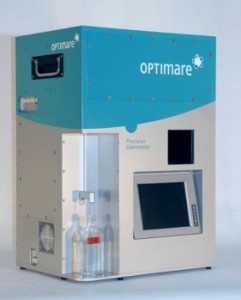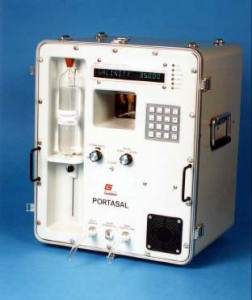There are only a few salinometers that can meet requirements of the high precision laboratory measurement of salinity:
Guildline 8400B Autosal
The worldwide recognised industry standard instrument for CTD-calibration and measuring salinity in the laboratory.
Modified version of the original T.M.Dauphinee salinometer circa 1975.
More than 40 years in the leading position!
Guildline 8410A Portasal
Portasal offers automatized laboratory precision salinity measurement in a portable case, however it still requires a thermocontrolled laboratory. This is 1990’s Guildline development that uses a microprocessor technology which improves some features of the Autosal, but on other hand makes it less accurate.

RBR Micro-Salinometer MS-315
RBR’s portable salinometer, the MS-315e is based on a new concept where the salinity of a sample is derived from the ratio of the conductance of the sample simultaneously compared with the conductance of a reference (ratiometric). Every sample is therefore standardized, and the standard itself is enclosed in glass to preserve the integrity of measurement for weeks. This dual cell innovation removes the need for highly stable bath temperatures, and the cells are surrounded by a well stirred oil bath to ensure thermal uniformity.
The MS-315e provides oceanographers with a reliable shipboard method to verify the performance of sophisticated modern CTD instruments. By giving a direct measurement of Rt against the reference it gives a rapid confirmation of accuracy of a CTD with low operating costs. Remote control and automation is achieved with the the MS-315e through the Ethernet interface. Using Ruskin and this Ethernet connection the MS-315e is capable of automatically measuring directly from sample bottles, pipelines, saltwater reservoirs, fish tanks, and calibration baths without the operator being present at the measuring site. Ruskin (our configuration and analysis software) interfaces with the MS-315e through an Ethernet connection and can command the MS-315e to fill or flush the measuring cells. The number of cycles of fills and flushes before a measurement is defined by the operator. TCP/IP sockets complement the graphical interface with both data output and a control channel using a simple command language, permitting complete integration into laboratory workflows.

 Paper A New Method of Salinometry
Paper A New Method of Salinometry


Optimare OPS
The OPTIMARE Precision Salinometer is based on recent development of Klaus Ohm, Alfred Wegener Institute for Polar and Marine Research. Fully automated measuring system includes SBE-3 and SBE-4 CT-sensors submersed into the thermally controlled bath.







 Visit Today : 204
Visit Today : 204 Visit Yesterday : 150
Visit Yesterday : 150 This Month : 2471
This Month : 2471 Total Visit : 242252
Total Visit : 242252 Hits Today : 270
Hits Today : 270 Total Hits : 615399
Total Hits : 615399 Who's Online : 2
Who's Online : 2